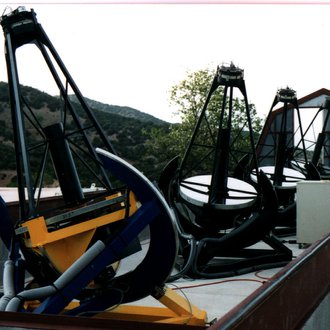APT
If somebody ventures to the dawn of Robotic Astronomy, she will probably stumble across Fairborn Observatory and it's 1979(!) installation of what was maybe the first fully functioning APT - an automated photoelectric telescope (L. J. Boyd, R. M. Genet & D. S. Hall). In 1985, Smithsonian provided a site at their Fred L. Whipple Observatory on Mt. Hopkins, and in 1989 already seven APTs were in operation in a single building that was slaved to a weather station, thus enabling fully autonomous operation. In early 1996, the University of Vienna bought two of the then eight telescopes, namely T6 and T7 and termed them Wolfgang and Amadeus, after the famous Austrian composer Johannes Chrysostomus Wolfgang Theophilus Mozart. In the same year, all APTs were relocated to Washington Camp in the Sonoran desert near Nogales, Arizona. This new site started with three similar buildings with roll-off roofs. Opening and closing was again slaved to a weather station, with some short-term weather prediction implemented by T. Granzer. Over the years, Fairborn observatory continued to grow and was steadily maintained by its long-term director, L. Boyd. Currently it harbors more than a dozen telescopes (see Automated Astronomy Group at Tennessee State University for current status and Google Maps for an aerial view).
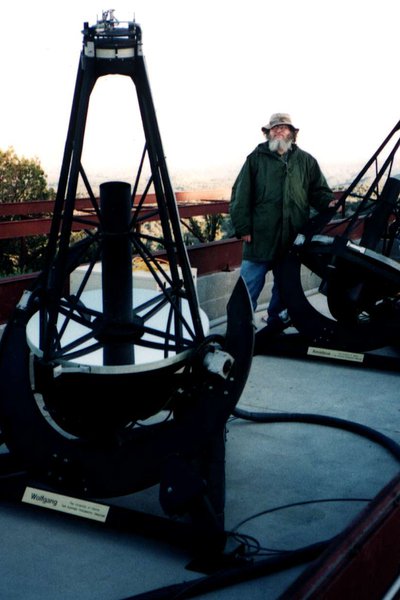
Wolfgang & Amadeus after the successful move to Fairborn Observatory, 1996.
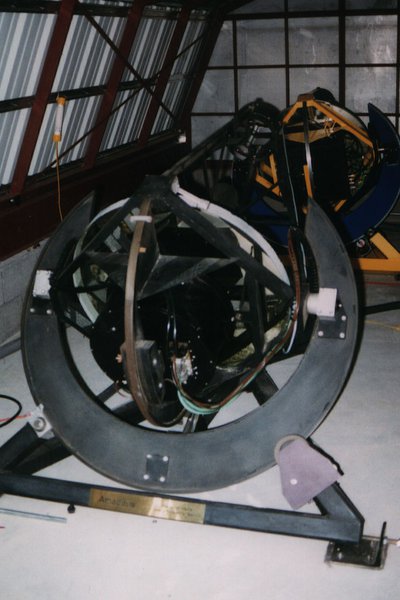
Amadeus (T7) in parking position. The telescope in the back is T8 of Tennessee State University.
Both telescopes have an identical optical design, with a 75cm primary in a Cassagrain system totaling at f/8 (Telescope details can be found in Strassmeier et al., 1997). The only science instrument is a photomultiplier tube (PMT). Wolfgang uses a blue-optimized EMI-9124QB while Amadeus employs an EMI-9828, which is optimized for longer wavelength. Acquisition is done with a frame transfer CCD camera, type PULNIX TM-840N, which offers 800x490 pixel at 11.5x13.5 μm. The mount is equatorial and reaches a pointing accuracy of ~30 arcsec; the attainable slew-speed tops at 10 deg/sec. Photometric filters were selected according to the spectral response of the PMTs and include Johnson-Cousins UBVRI, Strømgren uvby and wide and narrow hydrogen Hα and Hβ. The telescopes operate in an autonomous fashion with instructions written in ATIS-93 (Automated Telescope Instruction Set, version 1993). Target scheduling is achieved via a simple dispatcher (a greedy heuristics) using pure constraint statisfaction (target within hour angle and elevation constraints; maximum number of observations per night) enhanced with a three-stage merit determination that relies, firstly, on a fixed priority assigned to the target, secondly on the yet-to-be-done observations within the current night, plus finally on the remaining observing time window for any given target. Data reduction is done after the nightly data has been transferred to AIP and targets a full-sky solution. The four relevant parameters ζ, k',ε, and k" are deduced from the 40-50 standard stars observed every night along with the scientific groups. Various statistical test are employed to assess the validity of the deduced parameter values (i.e., to determine if a night is photometric); several routines to estimate ζ, k',ε, and k" for non-photometric nights have been established, see Granzer et al., 2001.
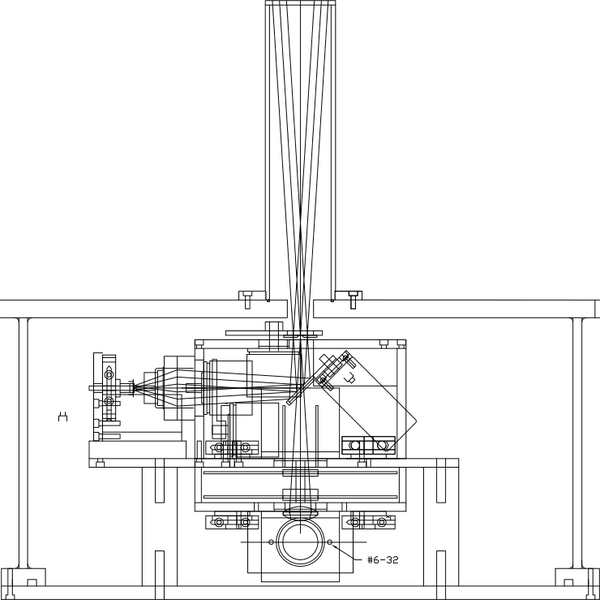
Light is split by a grey beam-splitter that diverts 4% to the acquisition CCD on the left edge. Main light path continues to the photo-multiplier tube.
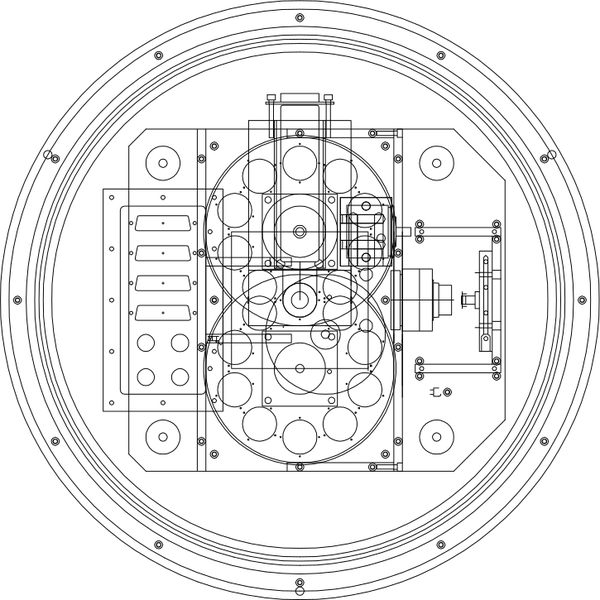
View into the focal plane. Two filter wheels are visible in front of the fused-silica entrance window for the photo-multiplier tube.
The Sun's magnetism manifests itself most prominently in dark features on its photosphere, known as Sun spots. They have been observed for centuries, first confirmed observations with a telescope date back to Galileo Galilei. However, they induce an overall variability level of the Sun's brightness of just 1 mmag spanning a rotational period. To reach such a precision on stars in ground-based studies is almost impossible to achieve. Nevertheless, many stars are known that show light-level variations caused by so-called star spots that are orders of magnitude higher then the Sun's. Another well-known property of the Sun's magnetism is its 11-year long cycle. During activity maximum, the number of Sun spots increases vastly. However, the light level does not change much in the visual passbands, which is mainly caused by an increase of bright chromospheric features (plages) during periods of enhanced Sun spot activity, thus more than nullifying the effect of darkening due to Sun spots. A question arising immediately is whether such decade-long cycles can be proven to exist also in other sun-like stars. To answer such a question, it is obvious that one needs decade-long observations. With Wolfgang & Amadeus being operational for more than two decades, such long-term studies are possible. Below we show some examples of highly-active stars and their light-level changes over periods of ~5k-days. Higher short-term amplitudes are interpreted as increased star-spot activity, while the long-term change of amplitudes are manifestations of the activity cycles of these stars. Note also that the overall light level of these stars change quite dramatically-different to the almost constant light level in the solar case.
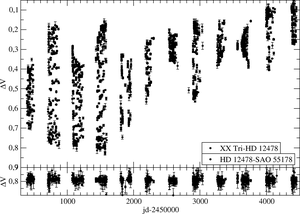
XX Tri, Johnson V (to HD 12478)
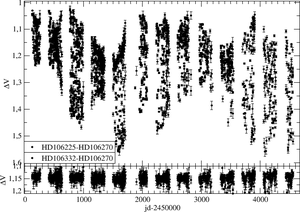
HD 106225, Johnson V (to HD 106270)
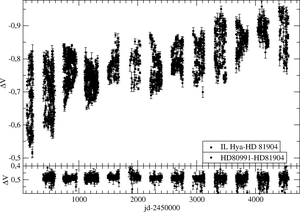
IL Hya, Johnson V (to HD 81904)
The project started as a special research program of Austrian science foundation FWF and was transferred after the initial funding period of five years into a joint project of AIP and the Institute for Astrophysics of the University of Vienna. It later then became a project together with Nicolaus Copernicus Astronomical Center (CAMK) . Ownership of the telescopes was transferred to AIP (Amadeus, T7) and to CAMK (Wolfgang, T6). In 2019, Amadeus was finally decommissioned after providing more than two decades of almost continuous photometry of some of the brightest stars in the sky.
